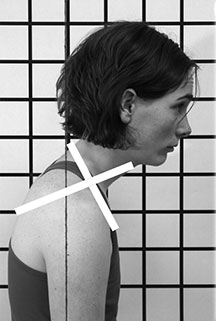Head Posture and Myofascial Pain
- Whitney Lowe
Sun A, Yeo HG, Kim TU, Hyun JK, Kim JY. Radiologic assessment of forward head posture and its relation to myofascial pain syndrome. Ann Rehabil Med. 2014;38(6):821-826.
This study attempts to evaluate computer terminal related forward head posture. Forward head posture exaggerates an anterior curve in the lower cervical region and posterior curve in the upper thoracic region. Numerous pain complaints and biomechanical dysfunctions are associated with forward head posture, so this study is certainly an admirable attempt to investigate the problem. However, the study comes up with some questionable conclusions.
Many people who sit at a computer terminal for long hours every day complain of an increase in upper back and cervical pain as a result. Spending prolonged periods in any static position is a now well-established cause of myofascial pain and dysfunction. Painful trigger points often develop in muscles as a result of prolonged periods in a static position. The development of trigger points has been defined as myofascial pain syndrome. The authors of this study state that myofascial pain syndrome is defined as “regional muscle tenderness originating from myofascial trigger points”.
In this study the researchers were attempting to determine if forward head posture, frequently associated with long periods of computer use, is directly correlated with an increase in myofascial pain syndrome. To make this determination, they took a cervical x-ray image of 80 participants (40 men and 48 women). They took precise measurements of anatomical landmarks to determine if there was a significant skeletal forward head posture.

For all participants they attempted to determine which had myofascial pain syndrome in the upper back or cervical region. A physician performed physical examination to determine if there were myofascial trigger points present in the neck, shoulder, and upper back regions. However, there was no specific mention of whether this physician had additional training in identifying myofascial trigger points. This is certainly a pertinent factor because most physicians are not trained in identification of myofascial trigger points through palpation.
The physician performing the investigation examined the scalene muscles, cervical paraspinals, upper trapezius, levator scapula, infraspinatus, supraspinatus, rhomboids, teres minor, deltoid, and SCM muscles. The most common location for trigger points was the upper trapezius and the second most common location was the cervical paraspinal muscles.
After calculating variables of head position and the presence of myofascial trigger points, the researchers performed a comparative analysis to determine if the individuals with a forward head posture also had an increased incidence of myofascial pain syndrome in the cervical region. In their results they stated: “There was no relationship between the forward head position in the presence, location, and number of trigger points, suggesting that the mechanism of pain related to the forward head position does not account for myofascial trigger points.” These results seem surprising because most would predict that myofascial pain syndrome would be more common for individuals with a forward head posture.
The researchers suggested that one possible explanation for their findings is that cervical facet joints may be the cause of forward head posture pain instead of the soft tissues. While this seems feasible based on skeletal mechanics (there is increased facet joint compression with forward head posture), the idea that facet joint compression is the cause of soft-tissue pain in the cervical region has serious limitations.
Most of the pain sensations reported with long periods in forward head posture are felt in the soft-tissues of the cervical region and not in the joints. Massage therapists are well aware that these pain sensations are alleviated with soft-tissue manipulation, which would not impact the cervical facet joints, so the pain source is still most likely within the soft tissues and not the cervical facet joints.
There were notable limitations in the accuracy of this study. As mentioned earlier, it does not specify if the individual who was tasked with identifying myofascial trigger points through palpation was adequately trained to do so. Another potential flaw in the methodology of the study is using a static x-ray to determine forward head posture. Static forward head posture is different from that which might occur from prolonged postural stress. Individuals may not appear to have a forward head posture in a static x-ray where they are told to sit upright in a chair for the x-ray machine. Put that same person in front of their computer terminal for three hours, and the posture is likely to change. It would be more accurate to take the x-ray at the individual’s workstation to make sure it matches what occurs on a regular daily basis.
Another important factor with examining forward head posture this way is that chronic myofascial pain results from prolonged load on the myofascial tissues. An x-ray machine is not capable of measuring prolonged load on the myofascial tissues. Consequently an individual could put their head in a forward position for long periods and have significant myofascial pain but not have a skeletal adaptation to that posture that shows up when they sit upright in a chair for the x-ray machine.
While the goal of the study was good – people are spending increasing numbers of in front of devices – it failed due to methodology and conclusions. This study is an excellent example of how a good study on musculoskeletal issues can go bad without the involvement of those specifically trained in soft-tissue related skills, like palpation. Additionally, just because a study is published in a reputable journal, there can still be serious methodological flaws and one is warranted to be very careful about any conclusions that are drawn from a flawed study design like this one.

